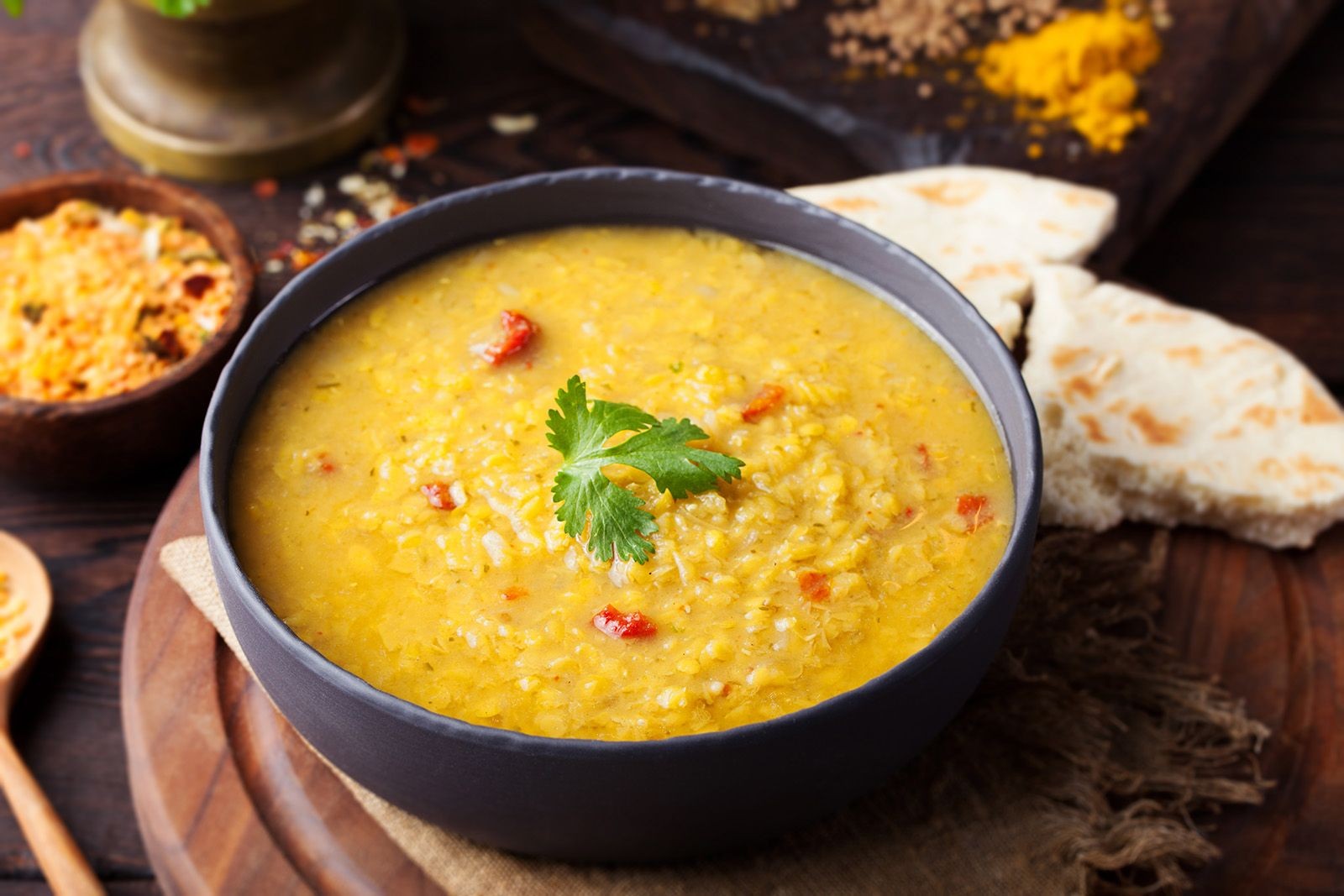Indian cuisine, a cornerstone of desi culture, is beautifully represented by this lentil dish, dal, served with chapatis.
Indian cuisine, often hailed as one of the world’s most diverse and flavorful, is more than just a collection of recipes; it’s a vibrant reflection of India’s rich history, diverse geography, and cultural tapestry. To truly understand India, one must explore its food. This journey into Indian gastronomy reveals a subcontinent where every spice tells a story and every dish is a celebration of regional identity and tradition. From the snow-capped Himalayas to the tropical coasts, the variety of Indian food is as vast and varied as the landscape itself. Indian cuisine has not only shaped its own cultural identity but has also left an indelible mark on global culinary history, with Indian spices being a major driving force behind the European Age of Discovery.
The Diverse Elements Shaping Indian Food
Workers in Punjab, India, are pictured threshing rice, highlighting the crucial role of rice cultivation in Indian agriculture and cuisine.
The remarkable diversity of Indian cuisine is intrinsically linked to India’s geographical variations. The towering Himalayas in the north dictate a cooler, alpine climate, while the rest of the country experiences a range of tropical and subtropical conditions. The Himalayan snowmelt and monsoon rains feed the extensive river systems of Northern and Central India, creating fertile alluvial plains ideal for wheat cultivation, a staple grain in the region. The fertile lands of the upper Ganga valley and Punjab also support sugarcane growth, adding sweetness to the Indian culinary landscape.
In contrast, Northwestern India, encompassing the Thar Desert in Rajasthan, presents a starkly different environment with sparse vegetation. Southern India, largely dry and rocky, is separated from the north by the Vindhya mountains and the Narmada River. These regions with less water availability cultivate drought-resistant crops like millets and corn (maize), showcasing the adaptability of Indian agriculture. However, Southern India is also blessed with the Godavari, Krishna, and Cauvery rivers, which sustain pockets of fertile plains.
The western and northeastern coasts of India receive abundant rainfall, fostering the cultivation of rice, a water-intensive crop that becomes a staple in these regions. The Indian monsoon, a critical weather phenomenon, delivers over 75% of the country’s annual rainfall between May and September, profoundly impacting agricultural yields and, consequently, the availability of ingredients for Indian food. The timing and intensity of the monsoon are vital to the success of Indian harvests each year.
Combine harvesters work in a field of finger millet near Bengaluru, India, illustrating the importance of millets as a staple grain in drier regions of India.
Pulses, the edible seeds of legumes, are another essential component of the Indian diet, providing vital protein. “Dal,” a Hindi term for both raw and cooked lentils, is often considered India’s unofficial national dish. Hardy and adaptable, pulses like lentils, chickpeas, peas, and beans thrive in diverse Indian soils. They perfectly complement grains, forming the cornerstone of a balanced Indian meal. While rice and wheat dominate grain consumption, barley and various millets also hold significant places in regional diets and culinary traditions. Evidence of wheat cultivation in India dates back to 6500 BCE, suggesting its introduction from Central Asia. Wheat is typically ground into atta flour, the base for iconic Indian breads like roti and parathas. Barley, more prevalent in ancient India, finds mention in the Rigveda, and while less common today, it remains significant in Hindu religious ceremonies. Rice, a staple in western and southern India, boasts a history stretching back over eight millennia.
A farmer in Karnataka, India, spreads harvested corn (maize) to dry, showcasing the cultivation of corn in regions with less water availability.
India is also a treasure trove of indigenous fruits and vegetables. Gourds, eggplant (brinjal), Indian gooseberry (amla), jackfruit, and mangoes are just a few examples of produce native to the region. While the exact origins of okra (bhindi), coconuts, and plantains remain debated, their long-standing presence in Indian cuisine is undeniable. Onions, though originating in southwestern Asia, arrived in India and, alongside garlic, were historically avoided by orthodox Hindus and Jains. Sugar holds a prominent place in Indian food, with the refining process from sugarcane juice to crystals pioneered in India during the 3rd century BCE. The 16th century saw the arrival of Portuguese traders, introducing New World ingredients like potatoes, tomatoes, papayas, guavas, cashews, and chili peppers, all of which flourished in India’s climate and became integral to Indian cooking.
A vibrant arrangement of spices, including nutmeg, cloves, peppercorns, cardamom, and star anise, illustrates the complexity of garam masala and the central role of spices in Indian cuisine.
Spices and herbs are arguably the defining characteristic of Indian food. Indigenous spices like ginger, turmeric, tamarind, black pepper, cardamom, and sesame seeds form the aromatic foundation of countless dishes. Cumin, fenugreek, saffron, coriander, and asafoetida (hing), the latter a popular garlic substitute for Hindus and Jains, arrived from West Asia and the Mediterranean, enriching the Indian spice palette. Beyond flavor, spices were historically valued for their antibiotic properties, documented in ancient Indian texts detailing their medicinal benefits. Contrary to the common misconception, Indian food isn’t always about intense heat. Spices are skillfully used in whole, powdered, or ground forms not just to add spice, but to enhance the overall taste profile of dishes. Roasting spices often intensifies their flavors, and complex spice blends like garam masala (“hot spices”) are regionally unique and fundamental to Indian cooking. The allure of Indian spices and the lucrative spice trade were major catalysts for European exploration during the 15th and 16th centuries, driving voyages by Vasco da Gama and Christopher Columbus in search of sea routes to India, aiming to bring these coveted spices back to Europe.
A Historical Taste of India
The culinary history of India is as layered and fascinating as its spice blends. The early Vedic civilizations, nomadic pastoralists who performed elaborate rituals to appease their deities, provide the earliest glimpses into Indian food traditions. Agni, the god of fire, was considered the divine mouth for offerings, with ghee (clarified butter) being a favored offering, a tradition that continues to this day. Animal sacrifices, including meat consumption, were part of these rituals. While the inclusion of cattle in sacrifices is debated, the topic of beef consumption remains sensitive in modern India. Barley was a common grain during this period, predating the prominence of wheat. Milk and dairy products like yogurt and barley-based porridges were also significant in their diet.
The first millennium BCE witnessed agricultural advancements and urbanization in Northern India. The concept of ahimsa (non-violence), originating in the Upanishads, gained prominence with the rise of Buddhism and Jainism. These religions promoted compassion for all living beings, fostering vegetarianism. Jainism, in particular, emphasized avoiding foods believed to incite passions, like onions and garlic, and discouraged consuming root vegetables due to the belief that harvesting them harms microorganisms. The Sanskrit grammarian Panini, in his 6th-5th century BCE work Ashtadhyayi, categorized food into meat, lentil soups, and vegetables, indicating a developing culinary structure. Chanakya’s Arthasastra, a manual on statecraft from around the 4th century BCE, details spiced food preparations, suggesting sophisticated cooking techniques. Ayurveda, the traditional Indian medicine system, categorized foods as sattvic (pure, balanced), rajasic (energy-boosting), and tamasic (energy-reducing), influencing dietary philosophies.
A vendor in Old Delhi, India, prepares chicken biryani, a dish that evolved during the Islamic conquest and showcases the rich culinary heritage of the region.
By the first millennium CE, the caste system deeply influenced Indian society, extending to dietary guidelines. Forbidden foods emerged, including onions, garlic, mushrooms, non-hunted meat, and alcohol, with strict rules against sharing food across caste lines.
The Islamic conquest of India introduced new flavors and ingredients, including fruits like apricots, melons, and plums, and a rich gravy-based cooking style. Kebabs and pilafs, cooked over coals, gained popularity, evolving into Mughlai cuisine, a significant part of Indian food history. Biryani, a celebratory dish of meat, rice, yogurt, onions, and spices, originated in Persia but was transformed in India during this era. Today, biryani boasts numerous regional variations, with Mughlai and Hyderabadi biryanis being particularly renowned. The arrival of New World vegetables via the Portuguese in the 16th century further diversified Indian cuisine. Goa, under Portuguese rule for 450 years, still visibly reflects Portuguese culinary influences.
Regional Indian Cuisines: A Culinary Mosaic
Naan, a popular Indian flatbread cooked in a tandoor, is served with kadai paneer, a flavorful cheese dish, representing North Indian cuisine.
Northern Indian cuisine bears a strong imprint of the Islamic conquest. Dairy products like milk, ghee, and paneer (cottage cheese) are liberally used. Vegetables are often simmered in yogurt or rich onion-tomato gravies. Flatbreads are central, with roti cooked on a griddle and naan and kulcha baked in a tandoor, a traditional cylindrical clay oven. Puri and similar breads are deep-fried in oil, typically groundnut oil. Meals commonly consist of flatbreads served with dal and vegetable dishes. Non-vegetarian fare includes kebabs and pilafs, sharing similarities with Pakistani cuisine. Samosas are a beloved snack. Street food like kachori and chaat are immensely popular, alongside sweets (mithai) such as gulab jamun, petha, and rasmalai. Northern Indian food is generally richly spiced. Regional variations include Rajasthan’s desert cuisine, featuring gram flour, and Kashmiri cuisine, known for mutton, dry fruits, and elaborate wazwan multi-course meals.
Eastern India, encompassing West Bengal and Odisha, uses less spice and favors mustard oil in cooking. Rice is the staple, cultivated in terraced fields. Freshwater fish is prominent, alongside pork, beef, mutton, and chicken. Poppy seeds are also frequently used. This region’s cuisine shares close ties with Bangladesh.
Southern India revolves around rice, eaten with sambhar (sambar), a lentil-based stew with tamarind and vegetables. Pickled fruits and vegetables are common accompaniments. Coconut oil and sesame (gingelly) oil are primary cooking mediums. Seafood is abundant along the coast. Southern Indian cuisines are diverse, including Andhra, Tamil, Chettinad, Kerala, and Mangalore. Each region prepares sambhar distinctively and uses different rice varieties. Tamil cuisine emphasizes six tastes—sweet, sour, salty, bitter, pungent, and astringent—aiming for balance in every meal, traditionally served on banana leaves.
Western India boasts unique coastal cuisines. Goan cuisine features rice and fish as staples. Goan Hindu food is mildly spiced with many vegetables, while Portuguese-influenced Goan cuisine incorporates beef and vinegar-based gravies like vindaloo. Coastal Maharashtra emphasizes fish and rice, while inland areas use millets and groundnuts instead of rice and coconut. Gujarat is predominantly vegetarian, with sweet notes in many dishes due to sugar. Roti, dal, and vegetables are common.
Across India, food is traditionally eaten by hand, minimizing cutlery. Roti is used to scoop dal or vegetables, enhancing the tactile and immersive dining experience.
Indian Cuisine’s Global Footprint
Chicken tikka masala, a globally popular Indian dish, consists of tandoor-cooked chicken in a creamy tomato sauce.
Indian cuisine has transcended geographical boundaries, becoming globally accessible, especially in regions with significant Indian diasporas. Indian laborers who migrated to the Caribbean, Southeast Asia, and Fiji brought their culinary traditions with them. Rice, flatbreads, and curries are staples in Trinidad and Tobago, with roti-based street food being particularly popular. Pholourie (chickpea fritters) in Guyana, vindaye in Mauritius, and “tinned fish” curry in Fiji are all testaments to Indian culinary influence.
South Africa also shows Indian influences, most notably in bunny chow, a meat curry served in a loaf of bread. Tamil influences are strong in Malaysia and Singapore, where roti canai, an Indian-inspired flatbread, is popular with meat curries. Indian food has long been popular in the UK; London’s Norris Street Coffee House advertised curry in 1773, and today chicken tikka masala is a national favorite. Indian restaurants are widespread in North America, often offering a diverse range of regional Indian cuisines.
Indian food’s global journey underscores its adaptability and enduring appeal. From its ancient roots to its modern global presence, Indian cuisine continues to evolve, delighting palates worldwide and cementing its place as a truly global cuisine.

